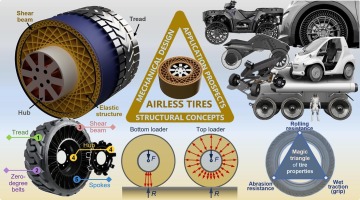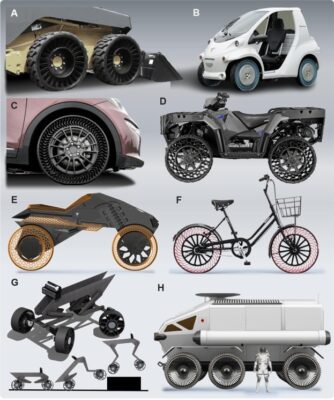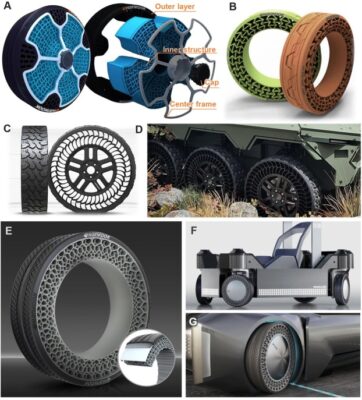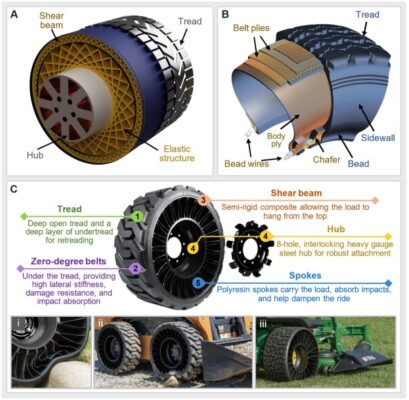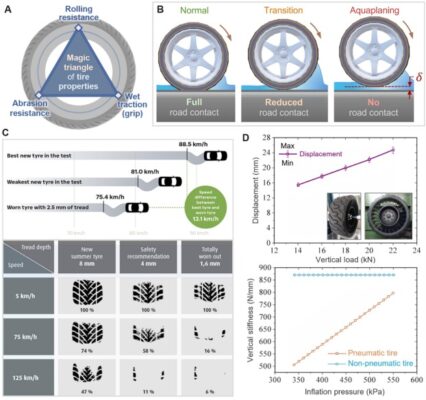
Abstract
The emergence of airless, or non-pneumatic, tires as a modern alternative to pneumatic tires is a relatively recent area of research in the transportation field. In this paper, we examine the advantages driving the development of non-pneumatic tires, along with the challenges currently hindering their widespread adoption. We will then establish a common structure for the modern non-pneumatic tire, dividing it into its key components.
The conventional purpose, desirable characteristics, and impact of each component on overall tire performance will be derived from the literature, and the merits of recent developments in this field will be critically evaluated where appropriate. The discussion will primarily focus on the elastic support structure, the component that directly replaces air and has been the focal point of most research. The paper will conclude by consolidating the progress of each component, discussing their influence on the prospects of non-pneumatic tires, especially in new applications, and identifying areas for further research.
Keywords
Airless tireNon-pneumatic tire (NPT)Honeycomb structureMulti-terrain mobilityAuxetic metamaterial
1. Introduction
The radial pneumatic tire (PT), having undergone over a century of development and practical use since its invention in the late 1800s, is now firmly established as a standard commodity for road-going transport. It is utilized across various industries in applications ranging from aircraft landing gear to truck tires [[1], [2], [3]]. In contrast, the airless tire, also known as the non-pneumatic tire (NPT), has found diverse applications, including construction machinery and robotic space rovers. The mechanical properties of NPTs are generally highly adaptable; by adjusting spoke and cell parameters, engineers can tailor their mechanical performance for specific uses. Notably, key mechanical properties of NPTs—such as stiffness, deflection, and rolling resistance—can be optimized to achieve desired performance characteristics, such as enhanced durability or reliability.
The primary motivation for an operator or purchaser to consider switching to non-pneumatic tires (NPTs) is likely cost. The economic benefits of NPTs are evident in both the direct potential for extended service life and the indirect reduction in tire maintenance and machine downtime costs over the tire’s service life. Secondary benefits could include reduced environmental impact and a decreased risk of harm resulting from “blowouts,” a particularly significant factor for road-going vehicles. Tire-related incidents are estimated to cause 414 fatalities and 78,392 crashes annually on U.S. roads [4]. However, these benefits are moot if the performance characteristics of NPTs render them otherwise unviable.
The main issue preventing broader adoption has been identified as a compromise in vertical stiffness, which must balance ride comfort with rolling resistance and load-carrying capacity [5]. While this compromise also exists in pneumatic tires [6], it is less pronounced [7] and can be mitigated through air pressure adjustments. Additional challenges to NPT adoption include their higher overall mass, poorer heat dissipation at speed [8], and the underdevelopment of manufacturing techniques typical of emerging technologies.
Despite these limitations, NPTs are being developed for a wide range of vehicle applications. Fig. 1 illustrates various airless tires used in vehicles ranging from heavy construction machinery and all-terrain vehicles (ATVs) to mobile robots and space rovers. Fig. 1A depicts an NPT on a skid steer digger [9]. Fig. 1B shows a Toyota COMS equipped with Bridgestone’s airless tires, known as the Air Free Concept [10]. Fig. 1C illustrates a Michelin’s Uptis NPT on a car prototype developed in partnership with GM [11,12]. Fig. 1D features a military-grade all-terrain vehicle (ATV) utilizing NPTs [13]. Fig. 1E showcases an electric bike with distinct 3D-printed front and rear airless tires [14]. Fig. 1F depicts Bridgestone’s proposed next-generation bicycle tire designed using Air Free Concept [15]. Fig. 1G displays the AGRO 2, which combines a hybrid wheel-leg design with non-pneumatic tires [16]. Finally, Fig. 1H presents Toyota’s Lunar Cruiser concept, equipped with airless tires designed for the Japan Aerospace Exploration Agency (JAXA) to facilitate lunar surface exploration [17,18].
Fig. 1
This review aims to investigate the potential of emerging non-pneumatic tires as viable replacements for conventional pneumatic tires in manned vehicles, with a broad exploration of the engineering advances that have enabled these innovations. The primary objective is to examine the structural concepts, mechanical design, and application prospects of airless tires, providing a comprehensive analysis of their performance, associated challenges, and potential improvements. In doing so, this review seeks to bridge the gap between recent technological developments and their practical implementation, offering insights into the future of tire design.
This paper is structured as follows: following this introduction, Section 2 presents an overview of the historical milestones in NPT technology, establishing the context for recent innovations. Section 3 delves into the core structural components of NPTs, focusing on the tread, hub, shear beam/band, and elastic structures, emphasizing their role in load-bearing capacity and overall tire performance. Section 4 explores material selection and environmental impact considerations, discussing sustainability aspects and potential lifecycle benefits. Section 5 extends the discussion to market analysis, evaluating the commercial feasibility, potential applications, and adoption challenges of NPTs. Finally, Section 6 concludes the paper by outlining future research directions, highlighting key limitations, and proposing potential advancements that could accelerate the widespread adoption of airless tire technology.
2. Overview of historical milestones in NPT technology
Although recognized as a recent development in technological history, the origins of the non-pneumatic tire (NPT) date back to the 1900s [[19], [20], [21], [22], [23], [24]], with numerous innovative designs of ‘spring wheels’ created between 1900 and 1970 (e.g., see [[25], [26], [27], [28], [29], [30], [31], [32], [33], [34], [35], [36], [37]]). Spring wheels were compliant structural systems designed to cushion strains between the hub and rim of the wheel [38], primarily aimed to eliminate the difficulties and risks associated with the punctures and blowouts of pneumatic tires.
One of the most remarkable airless tires dates back to 1938 when J.V. Martin introduced a safety tire featuring X-shaped spokes [39,40]. Building on such earlier efforts, in 1967, Roque [41] proposed a notable airless tire design, focusing on securely attaching the tire to the wheel rim. His invention incorporated a plurality of flexible struts positioned between the bead portions of the tire, each surrounded by a compression spring. The bead portions, having a width greater than the wheel rim, were compressed when mounted onto the wheel. The struts and springs then exerted an outward force, tightly pressing the bead portions against the wheel’s rim.
One of the next significant advancements in NPT design came in 1979 from Kubica and Schmidt [42], who proposed a tire consisting of an outer ring supporting a tread, an inner ring to be mounted on a hub, and supporting elements connecting these rings. The supporting elements were the first recorded to take a cellular form—hexagonal honeycombs running parallel to the tire’s axis. The engineers suggested sealing the cells with lateral walls to allow the tire to be optionally filled with air, though they emphasized that the tires would remain functional even in the event of a puncture. They suggested certain geometric design parameters, which they claimed provide the tire with resilience and wear properties similar to those of good-quality pneumatic tires.
In 1989, Palinkas and Page [43] introduced a design that incorporated cellular spokes as a key feature. Their tire design consisted of outer and inner coaxial members (referred to as “hoops”), with the outer hoop supported and cushioned by a series of circumferentially spaced planar ribs. A planar central web connected the hoops along their circumferential center lines. Shortly thereafter, Pajtas [44] expanded on this concept with the development of the side web non-pneumatic tire (SWNPT). This design introduced a side web for enhanced load-bearing capacity. The tire featured angularly oriented, oppositely directed planar rib members (referred to as “crossed ribs”) integrally connected by a single planar web member on one side. This configuration formed a non-expansible annular honeycomb structure sandwiched between the inner and outer hoops, with at least one row of passages having a quadrilateral cross-section.
Although early advancements in NPTs laid the groundwork, significant progress in their development took off in the 2000s. Michelin introduced the “Tweel” [45,46] in 2005, an airless tire that merges the functions of a tire and wheel into a single design invented T.B. Rhyne and S.M. Cron. Its structure consists of a rigid hub connected to a shear band through flexible polyurethane spokes, delivering effective shock absorption without relying on air. Similarly, Hankook Tire began its NPT research in the early 2010s (Fig. 2A) and unveiled the airless ‘i-Flex’ concept in 2015 (Fig. 2B), claiming it offered enhanced safety, comfort, and fuel efficiency, thereby highlighting its potential for widespread use in the automotive industry [47].
Fig. 2
In 2013, Bridgestone unveiled its next-generation NPT concept tire highlighting enhanced load support and eco-friendly advantages. This design incorporates a distinctive thermoplastic resin spoke structure, improving both performance and recyclability. In 2019, Michelin collaborated with General Motors to develop the “Unique Puncture-proof Tire System” (Uptis) which integrates an aluminum wheel assembly with composite-reinforced rubber. The second generation of Hankook’s NPT called ‘i-Flex2′ (Fig. 2C-D) was introduced in 2022. Subsequently, Hankook introduced an updated version of the concept, featuring a biomimetic design that improved shock absorption, load-bearing capacity, and safety while reducing maintenance costs, making it an especially viable option for autonomous mobility applications [48], as depicted in Fig. 2E-G.
During the 2010s, NASA’s Glenn Research Center designed the “Superelastic Tire” to support exploration missions on the Moon and Mars [49]. Drawing inspiration from the tires used during the Apollo missions, this innovative non-pneumatic tire incorporates shape memory alloys, enabling it to withstand harsh temperatures and rugged terrain. This breakthrough provides a robust and resilient alternative to traditional air-filled tires for space exploration.
3. Non-pneumatic tire (NPT) structure
A non-pneumatic tire’s structure can be categorized into three primary components, as depicted in Fig. 3A. These components correspond closely to the sections of a pneumatic wheel and tire assembly [54], as shown in Fig. 3B:
- •
Outer tread: This layer contacts the ground and provides grip.
- •
Support structure: This replaces the air pressure and carcass (sidewall and ply) in traditional pneumatic tires.
- •
Hub: This component connects the tire assembly to the vehicle’s wheel mounting assembly, serving a similar function as a conventional wheel.
Fig. 3
However, most non-pneumatic tire designs do not consist solely of these three parts. The support structure is typically divided into two key areas:
- •
Shear beam/band: A crucial element for torque transmission and load support.
- •
Elastic structure: Designed to replicate the cushioning and deformation provided by air pressure in pneumatic tires.
Both of these areas are pivotal for ongoing advancements in the geometry and materials of NPTs [55,56]. Fig. 3C showcases the anatomy of the Michelin Tweel NPT and highlights some of its practical applications.
The division of a non-pneumatic tire into three parts facilitates a more direct comparison to a pneumatic tire assembly, which consists of a tread and belt, casing/sidewall, and wheel [1,57,58]. Each component of the NPT mirrors a function of its pneumatic counterpart, tailored to achieve comparable or superior performance. The specific purpose and function of each component, along with the desired properties for use in manned vehicles, will be elaborated on in the subsequent sections.
3.1. Tread
The tread of a tire refers to the patterned rubber on its circumferential surface that contacts the road or ground, transferring longitudinal (tractive) and lateral forces during cornering through grip (friction) between the vehicle and the surface [61,62]. The static frictional force, f, is described by a proportionality between the coefficient of friction (μ) between the tire and the surface, and the normal force (FN), according to the equation f = μFN [63,64]. As a tire is used, the tread gradually wears down, diminishing its ability to provide effective traction.
Developments in tread materials are generally aimed at reducing tread wear without compromising the frictional properties or rolling resistance of the compound, thus addressing the so-called ‘magic triangle’ of tread properties [[65], [66], [67], [68]], as illustrated in Fig. 4A.
Fig. 4
Aquaplaning, also known as hydroplaning, is a condition that can exist when a layer of water, wet snow, or slush builds up between a vehicle’s tires and the road, as depicted in Fig. 4B. Aquaplaning can significantly impair ground control and reduce braking effectiveness. There is a potential risk of the aquaplaning effect on the treads of both pneumatic and non-pneumatic tires. A key functionality of various tread pattern designs is to facilitate the evacuation of water in wet conditions and optimize the wear rate in different weather conditions [69].
Frolove et al. [72] demonstrated that various design parameters, including the type of tread pattern, play a crucial role in vehicle safety. Specifically, smooth tread patterns exhibit a higher lift coefficient compared to tires with serial patterns, impacting traction quality. On the other hand, tread segmentation (a built-in feature of the pattern design) improves water drainage and contact pressure distribution. Additionally, the roughness of the road surface significantly influences a tire’s traction properties.
In this context, Mikheev et al. [73] noted that non-pneumatic tires (NPTs) can provide higher traction force compared to conventional pneumatic tires. Similarly, optimizing tread patterns using geometric shapes can enhance traction, improve hydroplaning resistance, and reduce rolling resistance under various operating conditions [74]. Furthermore, Zhou and Wang [75] found that the layout angle of the tread blocks affects longitudinal grip, influencing vehicle performance in terms of braking, steering, and side-slip properties. They also observed the inverse relationship between tread depth and contact area size with the aquaplaning phenomenon at different vehicle speeds on a road with 3 mm of water thickness (Fig. 4C).
Another important factor influencing friction and wear is seasonal variation. For example, summer and winter conditions can impact wear rates, with higher rates in summer and lower rates in winter. Additionally, higher slip angles and speeds, often associated with terrain, can increase tread wear rates [[76], [77], [78], [79], [80]]. Rugsaj and Suvanjurmat [71] suggested that the tread design of Michelin Tweel NPT must account for higher vertical stiffness compared to conventional pneumatic tires. This increased stiffness affects its load-carrying capacity, in line with the expected vertical stiffness related to inflation pressure, as depicted in Fig. 4D.
Given that, at least at rest, the normal force is primarily determined by other parts of the vehicle and tire [81], the performance of a tire’s tread is assessed by its effective coefficient of friction. However, this must be balanced with durability in most applications, as many high-performance tread compositions experience increased wear due to abrasion [82]. The situation is further complicated by environmental factors such as water, terrain, and temperature, which significantly influence the coefficient of friction in practice [83]. These challenges have led to the development of specific tread patterns beyond a solid ring, incorporating tread blocks or grooves in designs now mandated for road use [84].
While the specifics of tread pattern design are beyond the scope of this review, studies by Blythe [85] and Fwa et al. [86] provide valuable insights into the topic. Innovations in tread material technology are discussed herein, with the primary difference between the tread on pneumatic and non-pneumatic tires lying in its implementation. Typically, on non-pneumatic tires, the tread is a separate component bonded to the support structure [87], whereas in pneumatic tires, it is often an integral part of the carcass [88]. In some designs, tread compounds may also form part of the support structure.
Source: ScienceDirect, Published: May,2025

